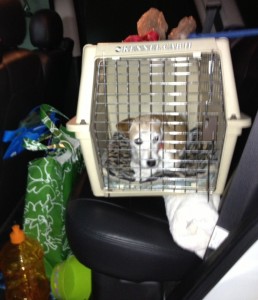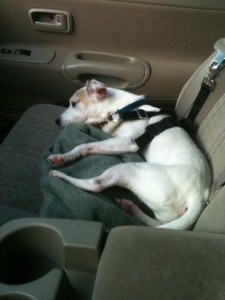Dog Walkin’ Wellington
Traveling with your Dog
By Barbara K. Phillippi
Spring is in the air, and as surely as some folks are planting gardens, others are planning summer vacations. Is it best to travel without your pooch, meaning a pet sitter, family member, or willing neighbor steps in, or are you going to jump through hoops to keep him with you at all times? You’ve already decided to make the trip, so let’s wade in and discuss practical stuff.
UP, UP, AND AWAY?
 If you’re thinking about taking to the not-so-friendly skies, you’ll need to be doing some serious research, long before you purchase your plane tickets. Discover which airlines service your itinerary, and don’t expect that pet costs and restrictions are uniform across that range of carriers! Check the prices and requirements of each; seating criteria and crate size, etc, differ from airline to airline. Here’s a partial list of questions that will be helpful when making Fido’s flight plans:
If you’re thinking about taking to the not-so-friendly skies, you’ll need to be doing some serious research, long before you purchase your plane tickets. Discover which airlines service your itinerary, and don’t expect that pet costs and restrictions are uniform across that range of carriers! Check the prices and requirements of each; seating criteria and crate size, etc, differ from airline to airline. Here’s a partial list of questions that will be helpful when making Fido’s flight plans:
-What types (sizes) of pets are allowed?
-How much is the Pet Fare?
-Will my pet be in cargo?
-How many pets are allowed per aircraft? (sometimes only 1 or 2 per flight, first come, first served)
-How many pet carriers is each customer allowed?
-Do animals assisting customers with disabilities count toward the maximum number of pets permitted?
-What types of pet carriers can customers bring?
-How big can my pet carrier be?
-Will pet carriers count as a carry-on bag or personal item?
-Are reservations for the pet required?
-Can Pet Fares be purchased on the airline website?
-What form of payment will be taken for a Pet Fare?
-Can pets earn frequent flyer miles?
-Do pets require any type of vaccinations or documentation?
-What do I do with my pet when I get to the security check point?
-Will Customers be able to pre-board because they are traveling with a pet carrier?
-Once onboard, can the Customer hold his/her pet?
-Is there an area at the airport for pets to relieve themselves?
-Will the Pet Fare be refundable if a Customer decides not to travel?
-Does the airline accept pet crates/strollers as checked baggage?
Here are a couple of examples of crate size regulations from two carriers – this is NOT a complete list, either of the number of airlines available or their requirements and regulations. I include them to show discrepancies between providers.
With American Airlines, the maximum size for cabin pet carriers is 19″ long x 13″ wide x 9″ high. Soft-sided pet carriers such as Sherpa bags may exceed these dimensions slightly because they are collapsible. Animals must be able to stand up, turn around and lie down in a natural position in the kennel. Soft-sided pet carriers are accepted as long as they are constructed of water-repellent, padded nylon with mesh ventilation on two or more sides.
On Southwest Airlines, the middle seat is the best pick if you’re traveling with a pet carrier, but not all airlines offer diverse crate size seating:
Window Seat: 19”L x 14”W x 8.25” H
Aisle Seat: 19” L x 14” W x 8.25” H
Middle seat: 19” L x 19” W x8.25: H
Many airlines have temperature restrictions also… if they are extreme, (too hot, too cold) and could be a health threat at any stop on the route, your dog may be denied boarding.
Feeding lightly or not at all prior to the flight helps prevent vomiting and soiling of the crate. A small dish attached to inside of the crate can permit watering by an attendant if there is a flight delay. Instructions detailing both pet and owner information, destination, health concerns, microchip info, your dog’s feeding and walking needs, etc., should be tied in a plastic bag, and attached securely to the crate.
International travel has its own list of requirements and procedures, which can include additional inoculations, health requirements, even the necessity of quarantine for entry into some countries.
Tranquilizing your pet
Many travelers ask their vets for ways to ease travel stress for an anxious pooch. Internet advice shouldn’t be trusted, so you should definitely have that conversation with your dog’s doctor.
anxious pooch. Internet advice shouldn’t be trusted, so you should definitely have that conversation with your dog’s doctor.
No matter which carrier you choose, one of the most important things to do when flying with your dog is to remain watchful. Be sure he is checked in properly, and sit near an airport window to watch and see that he is boarded onto the plane. Keep an eye on him while waiting together in a lobby or lounge. By being wary, you’ll decrease the risk of you and your dog being somehow separated on your trip.
THE ROAD TRIP
A road trip may be a challenge for your dog, especially if his only trips have been to the vet, or the groomer, and he’s thinking “uh, oh, it’s going to get bad when the car stops!” every time you put him into a vehicle. Start with short rides around the neighborhood, with a “cookie” treat at the end of the trip.
My dogs have always traveled in their crates, and sleep peacefully during the journey except for “pee” stops at reasonable intervals. Sometimes, I’ve traveled with three or four animals, all similarly accommodated while in the vehicle. Now, it’s just Gracie and me. I place her carrier on a rolled up rug, which keeps it level, on the rear seat, behind the driver. Door facing out, for easy access at stops, it’s anchored by an extra leash tied from the crate handle to the bars between the rear seat head rest and the seat back. Her leash and a plastic bag are readily available under the crate handle, which is tagged with important pet/owner info.
On the floor behind the front seat are a large bottle of water from home and a water bowl, which gets filled and offered at each stop. In a handled bag that can easily be carried into a hotel, along with the crate, is her food dish, more poop bags, paper towels, and enough food measured out into individual meals to complete the trip.
 If your dog isn’t crate trained, at least get him a sturdy harness that will prevent him from traveling around the car’s interior, always a distraction to the driver. Enclosed is a picture of my friend Rick Bailey’s Jack Russell Terrier, “Jumper Dog,” a seasoned road warrior, in his safety harness.
If your dog isn’t crate trained, at least get him a sturdy harness that will prevent him from traveling around the car’s interior, always a distraction to the driver. Enclosed is a picture of my friend Rick Bailey’s Jack Russell Terrier, “Jumper Dog,” a seasoned road warrior, in his safety harness.
Rick says, “Jumper Dog’s harness is made by Travelin’ Dog. I got it a couple of years ago at Pet Smart. I just checked online, and you can still find it. Others never were as strong or as comfortable as this one. They retail from $16 to $20-plus, depending on size. This gives him room to turn and move around, and most importantly, keeps him out if the back seat where I can’t watch him, and from jumping into my lap when I’m driving.”
“This harness also prevents him from jumping or falling out of the car if the window’s down, and he sees something he wants. He’s a “Jack” (Russell Terrier,) and needs to be protected from himself, as well as protected during a possible minor accident.
if the window’s down, and he sees something he wants. He’s a “Jack” (Russell Terrier,) and needs to be protected from himself, as well as protected during a possible minor accident.
Where will you stay during the trip itself, and after arrival at your destination? If it’s a short trip to a pet-friendly relative or friend, no problem. But if you stay over on the road, please, plan ahead. Don’t be one of those pet owners who sneak the dog into their hotel unit after dark. I know people who do this; one giggled that her beagle had defecated on the bed. She got an exorbitant bill from the hotel a month later. Your dog is NOT an exception, and you are NOT special. This thoughtless and selfish behavior is what causes hotels to stop accommodating animals, and pet fees to become prohibitive for responsible owners who play by the book. Imagine being the parent of a child with a severe pet allergy, who unknowingly checks into a room where a pet had previously been smuggled! What sort of night will that family enjoy?
There are websites which can help you find pet friendly locations, in every price range. The ASPCA has a page with links:
http://www.aspca.org/about-us/faq/pet-friendly-hotels.aspx
I also use
www.bringfido.com
Many individual hotel chain websites and independent travel sites let you indicate “pets” in the criteria when you’re searching for accommodations.
If you think that you and your dog will be welcome only at low end chain motels, think again. Gracie has stayed at the Westin in Lake Mary, FL, where there is a designated dog floor (#3), and at the Sheraton Riverside in Tampa, (NO pet fee both times, and the room rate well under $100 a night). She rides up and down, waits patiently for elevator doors to open, struts across the lobby.
We recently visited Florida’s Disney World, one of most patronized destinations in the world, where no pets are allowed on Park property. Yet Gracie went too, and bunked in for the day at WDW’s official pet care facility, “Best Friends Pet Care” in the resort.
In February, the rate was $26 per day, which begins an hour before the parks open until an hour after park closing. There are half-day, overnight, and extended stay rates also. Grooming, outside runs, and extra pampering are available if desired. Staff is extra fussy, facilities are immaculate. Gracie’s stay figured out at about $2.17 an hour, and I would take her again, with no qualms.
https://disneyworld.disney.go.com/guest-services/best-friends-pet-care/
Some of my friends and I, self-vaccinate, so be warned. You must provide a record of up-to-date inoculations, signed by a veterinarian, when your pet checks in. The facility allowed Gracie to stay this time, but I got a lecture, and was warned that she would not be permitted on subsequent visits without a veterinary signature on all her papers.
A note of caution. Removing a pet from his/her familiar environment and routine is confusing, and often upsetting for your pet, who is used to his/her limited world. If possible, keep to his regular feeding/walking schedule. If you know that your dog didn’t like kids at home, or is “iffy” with other animals, those propensities will be more acute in a strange location. Be alert for situations that might occur at a moment’s notice, and don’t chance a confrontation.
Remember that safe and happy travel with your pooch depends on your preparation before the day of departure. “Bon voyage!” May you and your pooch enjoy your adventure, and the miles that you travel together.
“In a perfect world, every home would have a dog, and every dog would have a home.”
Over a lifetime, Barbara Phillippi has had mostly “normal” dogs – a few German Shepherds and a bunch of wonderful “mutts,” each with its own wonderful, quirky, qualities. For many years, she taught 4-H dog obedience courses, under the authorization of Cornell University’s Cooperative Extension Services. That terrific program teaches the basics of dog behavior, of every breed, to young dog owners. Today she lives in Wellington with three Jack Russell Terriers – Woody, Gracie, and Buck. “These guys showed me a learning curve that I never knew existed!”

